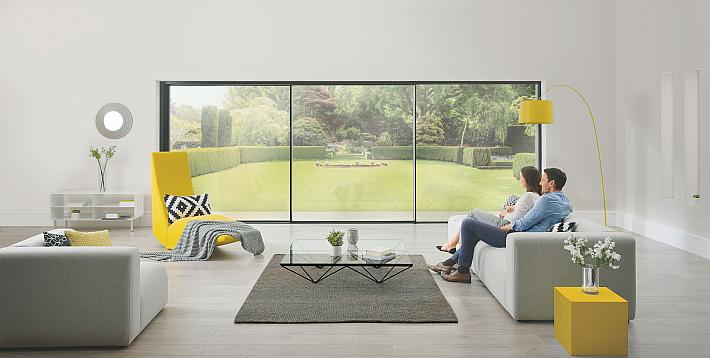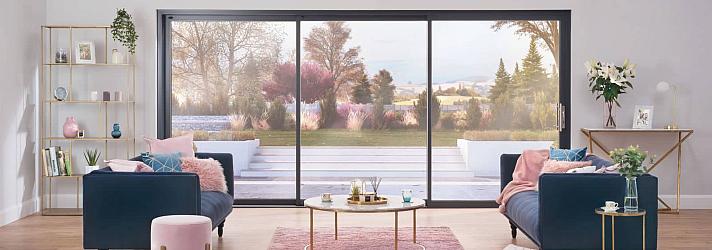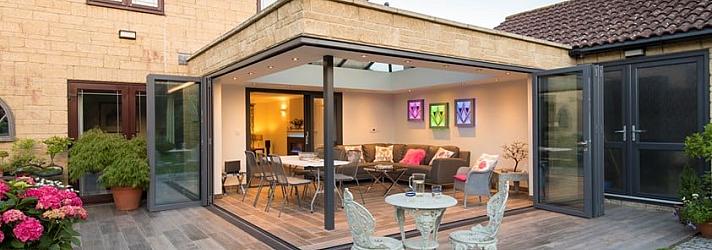
Slimline Sliding Doors. What are they?
Slimline sliding doors are sought after and on-trend right now. The minimal look, with reduced visible aluminium, makes these types of patio doors ideal for new extensions. Besides new builds, you can even use slimline sliding doors as a replacement for your dated patio door.
There are manufacturing and design differences between this latest generation of sliding doors and the more familiar ‘inline’ slider. Here’s everything you need to know about slimline and regular sliding doors for your home.
What are slimline sliding doors?
The best explanation of these types of sliders is doors with less visible aluminium profile than other types of doors. Importantly, the minimal look is especially desirable at the door mullions, also called interlocks.
As sliding doors have advanced in design, engineering and quality over the years, they’ve also got slimmer. The benefit is a better looking door, compared to timber or PVCu sliding doors. The other benefit is vastly improved views out to the garden or Kent countryside.
What determines an slimline or ultra-slim patio door is also down to some factors that are also personal to you.
For instance, a larger than normal aperture, say over five or six metres is less likely to show the aluminium profiles as much as a smaller opening. In other words, the framing on larger opening is paced further apart and less prominent as a result.
Sliding door sightlines
There are substantial sliding door products on the market, but most use popular sightlines you’ll find are included in our range.
Our slimmest door is the Origin OS-20 Artisan with sightlines at the mullion of just 20mm. Origin is one of the best brands of aluminium windows and doors on the market. FGC Bespoke Aluminium is a Premium Partner offering you the entire range of these outstanding windows and doors for your home.
The Origin OS-44 and OS-44 models offer mullion sightlines of 44mm and 77mm respectively. Your choice of these high quality patio doors depends on your personal taste. The OS-44 model is best for modern house styles and where you want the slimmest mullion. The Origin OS-77 sliding door provides a more classic looking door. You’ll probably prefer this model if your home has timber windows or more traditional looks where slim lines aren’t essential.
There are several types of sliding doors all offering slim sightlines.
- Conventional push/pull sliding doors
- Lift and slide patio doors
- Structurally bonded sliding doors
- Dry-glazed doors
In spite of the popularity of slimline sliding doors they do come with a few considerations. As the aluminium is slim face on, it’s often deeper front to back than dry-glazed doors front to back. In other words your door frames will look slimmer face on, but deeper viewed from the side.
Another consideration with slimline sliding doors is often the handles are recessed flush types. Slightly thicker sliding doors have more aluminium profile for fixing silver, black or white pull handles.
Structurally Bonded vs dry-glazed slimline sliding doors
Although both types of sliding doors provide excellent user experience, it’s how they’re made that sets them apart.
When choosing a door with a mullion below 35mm, it’s likely you’ll get a structurally bonded door. These types of doors are made around the glass in the factory. The glass gets bonded to the aluminium profiles. Essentially it becomes an integral part of the door, playing a big part in its overall strength and rigidity
Dry-glazed doors get manufactured without any glass. They leave the factory and come to your home unglazed. We fit the doors as normal and glaze them last.
It’s the more complex structurally bonded construction making slimline sliding doors with a 20mm mullion usually more expensive than their dry-glazed counterparts.
Large sliding doors must be strong, reliable, secure and weather resistant. Engineering and good design provide all of these features. Therefore, whether you choose a slimline or standard sliding door, you get excellent security and weathering across all our sliding door brands.
Inline vs lift and slide doors
Simply put, an inline sliding doors uses door rollers, the head and tracks to move the door. Lift and slide doors work via more complex gearing, raising the panel off the frame before it move. You can find out more about the differences between inline and lift and slide to help you choose what’s best for you.
Considerations with slimline sliding doors
There are a few things to consider when choosing slimline sliding doors. Knowing their features and limitations helps you buy better. Here’s what’s important to know with these products.
- The sightlines at the surrounding frame, head and track are always thicker than the 20mm door mullions. You won’t get a consistent line throughout the door set. This is the same for all similarly-designed patio doors.
- Usually slimline doors come double glazed with few options for triple glazing. You also can’t have integral glass blinds with these products.
- The deep frame also results in a deeper track. For new build openings ensure your installer works closely with your builder for the perfect end result.
- The flush or low threshold option is available with these types of sliding doors
- They only come as an inline version, not lift and slide.
These types of doors are often more complex to transport and handle. The glazed nature also means having to pass the glazed leaves through a property such as a terraced house. We can discuss all the various installation options with you.
Remember, there are dry-glazed doors with similar sightlines starting at 35mm that may be just as suitable. Our advice is always see products and compare them together.
The best patio doors from FGC Bespoke Aluminium
Whether you choose our range of sliding doors or our bespoke range of bifolding doors, we promise a transformational patio door for your home.
Contact us to discuss your requirements and let us improve your home with excellent views, security, style and energy efficiency.
Get in touch today to work with us on your next project.
Tell Us About Your Next Project
Send us details of your project or call to speak to a member of the team.
Request a Quote
Our products may be more affordable than you think.






